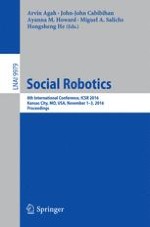2016 | OriginalPaper | Chapter
Look at Me Now: Investigating Delayed Disengagement for Ambiguous Human-Robot Stimuli
Authors : Melissa A. Smith, Eva Wiese
Published in: Social Robotics
Publisher: Springer International Publishing
Activate our intelligent search to find suitable subject content or patents.
Select sections of text to find matching patents with Artificial Intelligence. powered by
Select sections of text to find additional relevant content using AI-assisted search. powered by
